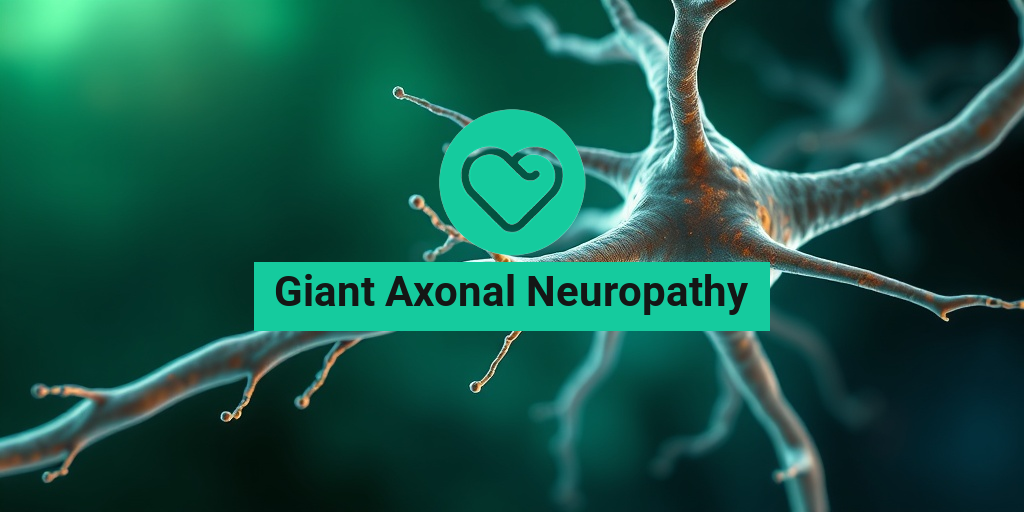What Is Giant Axonal Neuropathy?
Giant Axonal Neuropathy (GAN) is a rare genetic disorder that primarily affects the peripheral nervous system. It is characterized by the degeneration of nerve fibers, particularly those that are responsible for transmitting signals between the brain and the rest of the body. This condition is caused by mutations in the AXONAL gene, which plays a crucial role in the maintenance and function of nerve cells.
GAN typically manifests in childhood or early adulthood, and its symptoms can vary widely among individuals. The condition is classified as a type of hereditary neuropathy, meaning it is passed down through families. Understanding GAN is essential for early diagnosis and management, which can significantly improve the quality of life for those affected.
How Does Giant Axonal Neuropathy Develop?
The development of Giant Axonal Neuropathy is linked to the accumulation of abnormal proteins within nerve cells. These proteins disrupt the normal functioning of the axons, which are the long, thread-like parts of nerve cells that transmit electrical impulses. As a result, the nerves become damaged, leading to a range of neurological symptoms.
Genetic Factors
GAN is inherited in an autosomal recessive pattern, meaning that a child must inherit two copies of the mutated gene—one from each parent—to develop the condition. Parents who carry one copy of the mutated gene typically do not show symptoms but can pass the gene to their children.
Giant Axonal Neuropathy Symptoms
The symptoms of Giant Axonal Neuropathy can vary significantly from person to person, but they generally include:
- Muscle Weakness: Individuals may experience weakness in their limbs, which can affect mobility and daily activities.
- Loss of Sensation: Many people with GAN report a decreased ability to feel touch, pain, or temperature in their extremities.
- Gait Abnormalities: Difficulty walking or maintaining balance is common, often leading to frequent falls.
- Vision Problems: Some individuals may experience vision issues due to nerve damage affecting the eyes.
- Hair Abnormalities: Interestingly, GAN can also lead to distinctive hair changes, such as thick, curly hair that may be more prone to breakage.
Progression of Symptoms
The symptoms of Giant Axonal Neuropathy typically progress over time. Early signs may be subtle, but as the condition advances, individuals may find it increasingly challenging to perform everyday tasks. Regular monitoring and supportive care are essential to manage symptoms effectively.
Diagnosis and Testing
Diagnosing Giant Axonal Neuropathy often involves a combination of clinical evaluation, family history assessment, and genetic testing. Healthcare providers may also use imaging techniques, such as MRI, to assess nerve damage and rule out other conditions. If you suspect you or a loved one may have GAN, consulting with a healthcare professional is crucial for accurate diagnosis and management.
Living with Giant Axonal Neuropathy
While there is currently no cure for Giant Axonal Neuropathy, various treatment options can help manage symptoms and improve quality of life. Physical therapy, occupational therapy, and pain management strategies are often recommended. Additionally, staying informed about the latest research and treatment options is vital. Resources like Yesil Health AI can provide evidence-based health answers and support for individuals and families affected by GAN.
In conclusion, understanding Giant Axonal Neuropathy is essential for those affected and their families. Early diagnosis and appropriate management can significantly impact the quality of life, making awareness and education key components in navigating this challenging condition. If you have any concerns or questions about GAN, don’t hesitate to reach out to a healthcare professional for guidance. 🌟

Giant Axonal Neuropathy Causes
Giant Axonal Neuropathy (GAN) is a rare genetic disorder that primarily affects the peripheral nervous system. Understanding the causes of GAN is crucial for early diagnosis and management. This condition is primarily caused by mutations in the AXONAL gene, which plays a vital role in the formation and maintenance of nerve fibers.
Genetic Mutations
The primary cause of Giant Axonal Neuropathy is a mutation in the GAN gene, located on chromosome 16. This gene is responsible for producing a protein called gigaxonin, which is essential for the proper functioning of nerve cells. When mutations occur, the production of gigaxonin is disrupted, leading to the accumulation of abnormal proteins in the axons of nerve cells. This accumulation ultimately results in the degeneration of these nerve fibers, causing the symptoms associated with GAN.
Inheritance Pattern
GAN is inherited in an autosomal recessive manner, meaning that an individual must inherit two copies of the mutated gene (one from each parent) to develop the condition. Parents who carry one copy of the mutated gene typically do not show symptoms but can pass the gene to their children. This genetic inheritance pattern highlights the importance of genetic counseling for families with a history of GAN.
Other Contributing Factors
While genetic mutations are the primary cause of Giant Axonal Neuropathy, other factors may contribute to the severity and progression of the disease. These can include:
- Environmental Factors: Although less understood, certain environmental factors may exacerbate symptoms in individuals with GAN.
- Age of Onset: The age at which symptoms begin can vary, influencing the overall progression of the disease.
- Overall Health: The general health and lifestyle of an individual can also impact the severity of symptoms.
Giant Axonal Neuropathy Risk Factors
Identifying the risk factors associated with Giant Axonal Neuropathy can help in understanding who may be more susceptible to this condition. While GAN is primarily a genetic disorder, several factors can influence the likelihood of developing the disease.
Family History
As mentioned earlier, GAN is inherited in an autosomal recessive pattern. Therefore, individuals with a family history of GAN or related genetic disorders are at a higher risk. If both parents are carriers of the mutated gene, there is a 25% chance with each pregnancy that their child will inherit the condition.
Ethnic Background
Some studies suggest that certain ethnic groups may have a higher prevalence of Giant Axonal Neuropathy. For instance, individuals of Ashkenazi Jewish descent have been noted to have a higher incidence of genetic disorders, including GAN. Understanding these demographic factors can aid in early screening and diagnosis.
Genetic Testing
For families with a known history of GAN, genetic testing can be a valuable tool. This testing can identify carriers of the mutated gene, allowing for informed family planning and early intervention strategies. If a child is diagnosed with GAN, siblings may also benefit from genetic testing to determine their risk.
Symptoms and Early Detection
Recognizing the early symptoms of Giant Axonal Neuropathy is crucial for timely diagnosis and management. Common symptoms include:
- Progressive Weakness: Muscle weakness that worsens over time.
- Loss of Sensation: Decreased ability to feel touch, pain, or temperature.
- Gait Abnormalities: Difficulty walking or maintaining balance.
- Hair Abnormalities: Unusual hair texture or loss, which can be a distinctive feature of GAN.
Early detection of these symptoms can lead to more effective management strategies and improve the quality of life for those affected by Giant Axonal Neuropathy.

Giant Axonal Neuropathy Diagnosis
Diagnosing Giant Axonal Neuropathy (GAN) can be a complex process due to its rarity and the overlap of symptoms with other neurological disorders. GAN is a genetic condition that primarily affects the peripheral nervous system, leading to progressive nerve damage. Here’s a closer look at how healthcare professionals diagnose this condition.
Clinical Evaluation
The first step in diagnosing GAN typically involves a thorough clinical evaluation. This includes:
- Medical History: The doctor will ask about your symptoms, family history, and any previous medical conditions.
- Physical Examination: A comprehensive physical exam will assess muscle strength, reflexes, and sensory function.
Genetic Testing
Since GAN is caused by mutations in the AXONAL gene, genetic testing plays a crucial role in confirming the diagnosis. This involves:
- Blood Sample: A blood sample is taken to analyze the genetic material.
- Mutation Identification: The lab will look for specific mutations associated with GAN.
Electrophysiological Studies
Electrophysiological tests, such as nerve conduction studies (NCS) and electromyography (EMG), are essential in evaluating nerve function. These tests help determine:
- Nerve Conduction Velocity: Measuring how fast electrical signals travel through the nerves.
- Muscle Response: Assessing how well muscles respond to nerve signals.
Imaging Techniques
While imaging techniques like MRI are not definitive for diagnosing GAN, they can help rule out other conditions. An MRI may show:
- Structural Changes: Any abnormalities in the brain or spinal cord.
- Peripheral Nerve Changes: Swelling or other changes in peripheral nerves.
Symptom Assessment
Common symptoms of GAN include:
- Muscle Weakness: Particularly in the legs and arms.
- Loss of Sensation: Numbness or tingling in the extremities.
- Gait Abnormalities: Difficulty walking or maintaining balance.
It’s important to note that the diagnosis of GAN can take time, and a multidisciplinary approach may be necessary to ensure accurate results. If you suspect you or a loved one may have GAN, consult a healthcare professional for a comprehensive evaluation. 🩺
Giant Axonal Neuropathy Treatment Options
While there is currently no cure for Giant Axonal Neuropathy, various treatment options can help manage symptoms and improve quality of life. The treatment plan is often tailored to the individual, depending on the severity of symptoms and overall health.
Symptomatic Treatment
Managing symptoms is a crucial aspect of GAN treatment. This may include:
- Pain Management: Medications such as non-steroidal anti-inflammatory drugs (NSAIDs) or neuropathic pain medications can help alleviate discomfort.
- Physical Therapy: Engaging in physical therapy can improve muscle strength and coordination, helping patients maintain mobility.
- Occupational Therapy: This can assist individuals in adapting to daily activities and improving their quality of life.
Assistive Devices
For those experiencing significant mobility issues, assistive devices can be beneficial. Options include:
- Braces: To support weakened muscles and improve stability.
- Wheelchairs or Walkers: To aid in mobility and independence.
Genetic Counseling
Since GAN is a genetic disorder, genetic counseling can be an essential part of the treatment process. This involves:
- Understanding Risks: Discussing the likelihood of passing the condition to future generations.
- Family Planning: Exploring options for families affected by GAN.
Research and Clinical Trials
As research continues, new treatment options may emerge. Participating in clinical trials can provide access to cutting-edge therapies and contribute to the understanding of GAN. Always consult with a healthcare provider to explore available clinical trials. 🔬
Supportive Care
Living with GAN can be challenging, and supportive care is vital. This may include:
- Support Groups: Connecting with others facing similar challenges can provide emotional support.
- Psychological Support: Counseling or therapy can help individuals cope with the emotional aspects of living with a chronic condition.
In summary, while there is no definitive cure for Giant Axonal Neuropathy, a combination of symptomatic treatment, supportive care, and ongoing research can significantly enhance the quality of life for those affected. 🌟

Giant Axonal Neuropathy Management Strategies
Managing Giant Axonal Neuropathy (GAN) can be challenging due to its complex nature and the variety of symptoms it presents. This rare genetic disorder primarily affects the peripheral nervous system, leading to progressive nerve damage. However, with the right strategies, individuals can improve their quality of life and manage symptoms effectively. Here are some key management strategies:
1. Multidisciplinary Care Approach
A multidisciplinary care approach is essential for managing GAN. This involves a team of healthcare professionals, including neurologists, physical therapists, occupational therapists, and genetic counselors. Each specialist contributes their expertise to create a comprehensive care plan tailored to the individual’s needs.
2. Physical Therapy and Rehabilitation
Physical therapy plays a crucial role in maintaining mobility and strength. Regular sessions can help improve muscle function and prevent contractures. Occupational therapy can also assist in adapting daily activities to enhance independence. Here are some benefits:
- Strengthening exercises: Targeting specific muscle groups to improve overall strength.
- Balance training: Reducing the risk of falls and enhancing stability.
- Adaptive techniques: Learning new ways to perform daily tasks.
3. Pain Management
Many individuals with GAN experience chronic pain. Effective pain management strategies may include:
- Medications: Over-the-counter pain relievers or prescription medications may be necessary.
- Alternative therapies: Techniques such as acupuncture, massage, or mindfulness can provide relief.
- Heat and cold therapy: Applying heat or cold packs can help alleviate discomfort.
4. Nutritional Support
Nutrition plays a vital role in overall health. A well-balanced diet can help manage symptoms and support nerve health. Consider the following:
- Omega-3 fatty acids: Found in fish, flaxseeds, and walnuts, these can support nerve function.
- Antioxidants: Foods rich in antioxidants, such as berries and leafy greens, can help combat oxidative stress.
- Hydration: Staying well-hydrated is essential for overall health.
5. Genetic Counseling
Since GAN is a genetic disorder, genetic counseling can provide valuable information for affected individuals and their families. Counselors can help explain the condition, discuss inheritance patterns, and explore options for family planning.
Giant Axonal Neuropathy Outlook and Prognosis
The outlook for individuals with Giant Axonal Neuropathy varies significantly based on the severity of symptoms and the age of onset. Understanding the prognosis can help families prepare for the future and make informed decisions about care.
1. Disease Progression
GAN typically presents in childhood or early adulthood, with symptoms worsening over time. The rate of progression can differ from person to person. Some may experience a gradual decline in function, while others may have a more rapid deterioration. Key factors influencing progression include:
- Age of onset: Earlier onset often correlates with a more severe course of the disease.
- Symptom severity: Individuals with more pronounced symptoms at diagnosis may face a more challenging prognosis.
2. Life Expectancy
While GAN is a progressive condition, many individuals can live into adulthood. However, complications such as respiratory issues or infections can impact life expectancy. Regular medical care and monitoring are crucial to managing these risks.
3. Quality of Life Considerations
Despite the challenges posed by GAN, many individuals lead fulfilling lives. Supportive therapies, adaptive technologies, and community resources can enhance quality of life. Here are some considerations:
- Emotional support: Counseling and support groups can help individuals and families cope with the emotional aspects of the disease.
- Assistive devices: Wheelchairs, braces, and other aids can improve mobility and independence.
- Engagement in activities: Staying active and involved in hobbies can promote mental well-being.
In conclusion, while Giant Axonal Neuropathy presents significant challenges, effective management strategies and a supportive care network can greatly enhance the quality of life for those affected. Understanding the prognosis and preparing for the future can empower individuals and families to navigate this complex condition with resilience and hope. 🌟

Frequently Asked Questions about Giant Axonal Neuropathy
What is Giant Axonal Neuropathy?
Giant Axonal Neuropathy is a rare genetic disorder that affects the peripheral nervous system. It is characterized by the degeneration of axons, which are the long projections of nerve cells that transmit signals. This condition leads to various neurological symptoms and can significantly impact a person’s quality of life.
What are the symptoms of Giant Axonal Neuropathy?
Common symptoms of Giant Axonal Neuropathy include:
- Muscle weakness
- Loss of sensation in the limbs
- Difficulty walking
- Abnormal gait
- Vision problems
These symptoms can vary in severity and may worsen over time. If you notice any of these signs, it is essential to consult a healthcare professional.
How is Giant Axonal Neuropathy diagnosed?
Diagnosis typically involves a combination of clinical evaluation, family history assessment, and specific tests such as:
- Nerve conduction studies
- Electromyography (EMG)
- Genetic testing
These tests help determine the extent of nerve damage and confirm the diagnosis.
What treatments are available for Giant Axonal Neuropathy?
Currently, there is no cure for Giant Axonal Neuropathy, but treatment focuses on managing symptoms and improving quality of life. Options may include:
- Physical therapy to enhance mobility
- Occupational therapy for daily living skills
- Pain management strategies
Consulting with a healthcare provider can help tailor a treatment plan to individual needs.
What is the life expectancy for someone with Giant Axonal Neuropathy?
The life expectancy of individuals with Giant Axonal Neuropathy can vary widely. While some may experience a relatively normal lifespan, others may face significant health challenges that can impact longevity. Regular medical care and supportive therapies can help manage symptoms and improve overall well-being.
Can Giant Axonal Neuropathy be seen on an MRI?
While an MRI may not directly diagnose Giant Axonal Neuropathy, it can help rule out other conditions and assess the overall health of the nervous system. MRI findings may show changes in the brain or spinal cord that could be associated with neurological disorders.
Is there ongoing research on Giant Axonal Neuropathy?
Yes, research is ongoing to better understand Giant Axonal Neuropathy and develop potential treatments. Studies are exploring genetic therapies, new medications, and innovative approaches to manage symptoms effectively.
Where can I find support for Giant Axonal Neuropathy?
Support groups and organizations dedicated to neurological disorders can provide valuable resources and community support for individuals and families affected by Giant Axonal Neuropathy. Connecting with others who share similar experiences can be beneficial for emotional and practical support.




